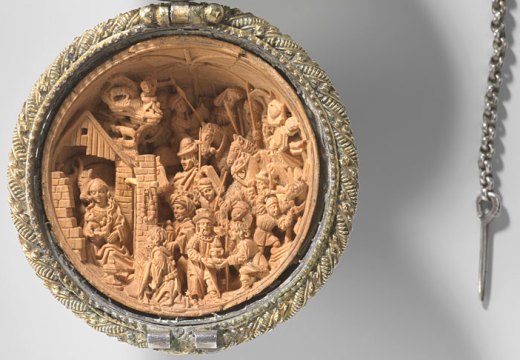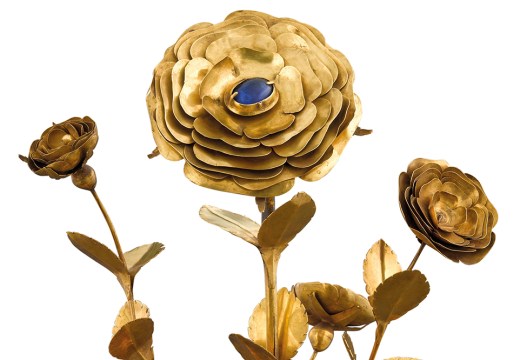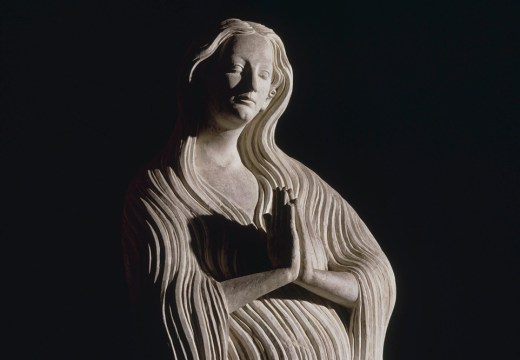From the December 2023 issue of Apollo. Preview and subscribe here.
In 1439, the city of Aachen planned to exhibit the relics of Charlemagne outside its great cathedral. But a plague broke out, and Aachen called off the show. This was a let-down for the thousands of pilgrims who had hoped for a glimpse of the holy. But it was even worse for a metalworker in Strasbourg, Johannes Gutenberg, who hoped to profit off those pilgrims by selling them souvenir badges: small, twisted pieces of wearable metal outfitted with a mirror, to capture from a distance the sacred light that the relics emitted. Flailing in debt, Gutenberg pivoted. He cast movable type instead and improvised his way to the modern printing press.
The city where I live – Hartford, Connecticut – has plenty of printed books to remind me of Gutenberg’s second phase. With famous former residents including the lexicographer Noah Webster and the scribbler Mark Twain, it can even be considered a Mecca of the American printed word. But there is only one object that calls to mind Gutenberg’s first replication scheme and its devout, anxious clientele. It is in the Wadsworth Atheneum, and it is fewer than four centimetres in diameter.
Now in two halves, the late medieval south German prayer nut once opened like a book. Inside are staged two scenes from the life of Christ in delicate miniatures carved in boxwood. Where to direct our gaze is not a free choice; this is a didactic theatre and a man is here to tell us. He points behind himself. He is the impresario, the master of ceremonies, an intruder from 15th-century life who stands in for the viewer. The Mary slumped in grief to his right is diegetic by contrast, part of the scene-within-the-scene. The pockmarks in the boxwood are a piece of crude realism given to the hills of Golgotha, while a sense of perspective is achieved by the subtle artifice of pricking the further hill with smaller, shallower holes. In front of the hills, the crowded composition offers an answer to the old theological riddle of how many angels fit on the head of a pin.
One passage in the work seems to aspire to Renaissance artistry: the drapery that flows behind the back of the crucified Christ. Otherwise, the Hartford object, which Dutch and German worshippers would have called a prayer apple, is not fancy. There exist more elaborate instances of boxwood miniatures, including prayer nuts that fold out into triptychs and casings as elaborate as a Gothic cathedral. The best can be traced back to the early 16th-century Delft workshop of Adam Dircksz, an artist conjured into existence by scholars on the basis of a single inscription on a prayer nut in Copenhagen. Down market from these touring masterpieces, anonymity reigns.
The carvers of the boxwood miniatures interest me less than their holders. What were these men and women seeking when they opened their pocket sculptures during the waning years of the Middle Ages? Julian of Norwich recorded seeing something of the kind in her book of mystical visions, Revelations of Divine Love, written around 1373. In that case God was the sculptor: ‘And in this he showed me a little thing, the quantity of a hazelnut, lying in the palm of my hand, it seemed, and it was as round as any ball. I looked thereupon with the eye of my understanding, and I thought, “What may this be?” And it was answered generally thus: “It is all that is made.”’
As one of the marginal sculptural forms, the sacred miniature is also feminine. Revelations of Divine Love is the first English-language book known to have been written by a woman. Giorgio Vasari writes about the Renaissance artist Properzia de’ Rossi that in the absence of expensive marble and prominent commissions, she turned to peach-stones: ‘It was certainly a marvel to see the entire Passion of Christ carved upon such a small peach-stone in the most beautiful intaglio, with countless characters besides the crucifiers and the Apostles.’ On the left margin of the Hartford miniature, far from the pair of pilgrims, a woman in her own private reverie gestures for silence. These objects were passed along and carried in the pockets of such women long before the dictates of fashion banished the female pocket altogether.
The 16th century adopted the printed book, but swept away the badges, the prayer apples and the souvenirs in a deluge of righteousness. One story records Walter Raleigh, the father of the explorer, overtaking an old woman on a road near Exeter, seeing her rosary, and demanding ‘what shee dyd with those beaddes’. She might have answered: they are all that is made. Instead Raleigh upbraided her, ‘entringe into further speeches with her concernynge religion which was reformed’. So the obsolescence of an entire class of objects was announced by a man on horseback. If they have washed up in our museums all the same, it is only because they drifted down along the undercurrents.
From the December 2023 issue of Apollo. Preview and subscribe here.
Unlimited access from just $16 every 3 months
Subscribe to get unlimited and exclusive access to the top art stories, interviews and exhibition reviews.














![Masterpiece [Re]discovery 2022. Photo: Ben Fisher Photography, courtesy of Masterpiece London](http://www.apollo-magazine.com/wp-content/uploads/2022/07/MPL2022_4263.jpg)
It’s time for the government of London to return to its rightful home